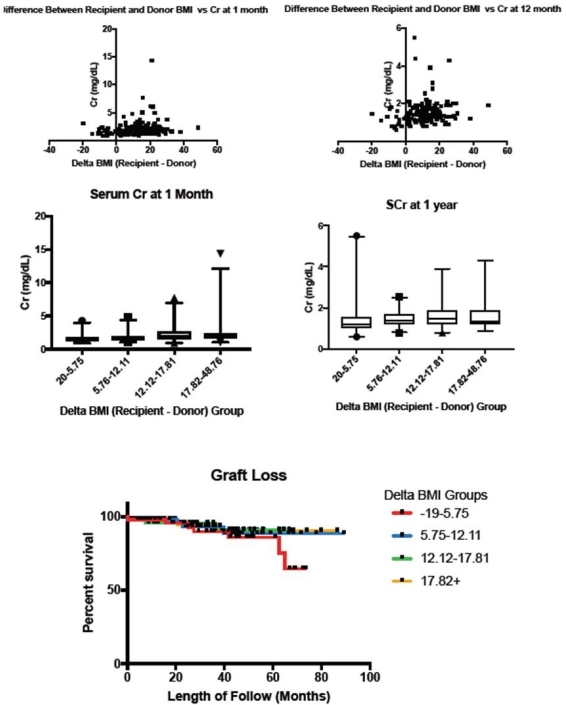Impact of the Differences between Body Mass Index of Recipient and Donor in a Population of Robotic Kidney Transplant
1Surgery, University of Illinois, Chicago, IL
2Surgery, Universit of Virginia, Virginia, VA.
Meeting: 2018 American Transplant Congress
Abstract number: 347
Keywords: Graft function, Kidney transplantation, Laparoscopy, Obesity
Session Information
Session Name: Concurrent Session: Kidney: Surgical Considerations
Session Type: Concurrent Session
Date: Monday, June 4, 2018
Session Time: 4:30pm-6:00pm
 Presentation Time: 5:06pm-5:18pm
Presentation Time: 5:06pm-5:18pm
Location: Room 210
Introduction: The recent introduction of minimally invasive technique allows to perform kidney transplant in otherwise suitable recipients regardless the recipient BMI. This could lead to a donor/recipient BMI mismatch that, in literature, is associated with an increased risk of graft failure due to hyper-filtration injury.
Material and Methods: Retrospective review of 203 consecutive robotic-assisted kidney transplants performed at a single center, between 2009 and 2017. The influence of the difference between donors and recipients BMI (delta BMI) on kidney function and graft survival were studied.
Results: Recipients were divided into 4 groups according to the difference between Recipient and Donor BMI (group 1= -20 – 5.75, group 2 = 5.76 – 12.11, group 3 = 12.11 – 17.81, group 4 = >17.82) using visualized binning. The average pre-transplant BMI for each group was 36±4.78, 39±5.87, 43±5.35 and 48±5.85 respectively (p<0.0001). Using univariate analysis, the mean serum creatinine at 1-month for groups 1-4 were found to be 1.598, 1.765, 2.242, and 2.431 mg/dL, showing that 1-month serum creatinine increases in parallel with the increase of “delta BMI” (p=0.0026). This difference was not found to be sustained when comparing 1-year serum creatinine between the 4 groups (p=0.5806). GFR at 1 month and 12 months were both inversely related to increase in delta BMI (p<0.001 and p=0.0028, respectively). However, overall graft survival was not affected by increase in delta BMI (p=0.6858). The 1-year graft survival was greater than 95% for all groups (group 1=98%, group 2=98%, group 3=95.7% and group 4=98%). 
Conclusions: Minimally invasive technique has allowed safe kidney transplantation in obese patients. In this setting, significant mismatch of BMI between donors and recipients are relatively common. We documented a trend for improved kidney function when delta BMI is kept to a minimum although the 1-year graft survival was not negatively affected by the degree of BMI mismatch.
CITATION INFORMATION: Tulla K., Tzvetanov I., Di Bella C., Gheza F., Spaggiari M., Oberholzer J., Benedetti E. Impact of the Differences between Body Mass Index of Recipient and Donor in a Population of Robotic Kidney Transplant Am J Transplant. 2017;17 (suppl 3).
To cite this abstract in AMA style:
Tulla K, Tzvetanov I, Bella CDi, Gheza F, Spaggiari M, Oberholzer J, Benedetti E. Impact of the Differences between Body Mass Index of Recipient and Donor in a Population of Robotic Kidney Transplant [abstract]. https://atcmeetingabstracts.com/abstract/impact-of-the-differences-between-body-mass-index-of-recipient-and-donor-in-a-population-of-robotic-kidney-transplant/. Accessed January 2, 2026.« Back to 2018 American Transplant Congress
